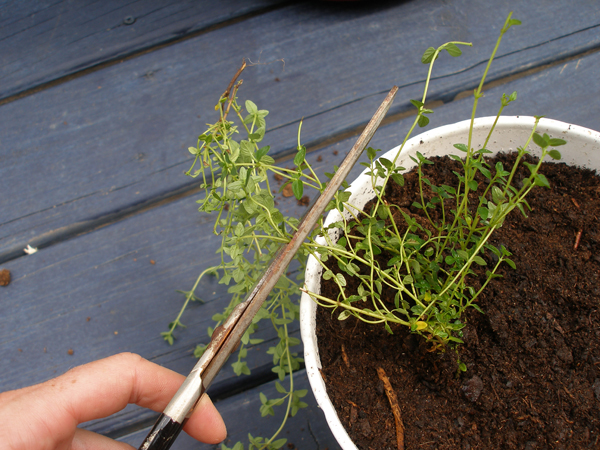 by Char Vandermeer
by Char Vandermeer
It’s easy to become overly attached to the herbs you’ve been growing all summer long. It seems a shame to leave Winston (the English thyme) and Ami (the tarragon) out there alone to confront winter’s whims.
So, before the first frost hits, hedge your bets and split your plants. Sure, thyme, tarragon, chives and rosemary might withstand a typical Philly winter, but it’s no longer a safe bet. If you’re a risk taker—and would rather avoid the whole transplanting hassle—simply trim the plant’s foliage back drastically, cover your herbs with a thick layer of mulch, move the pots to a sheltered location and hope for the best.
But I’m no gambler, and this year’s thyme, oregano and tarragon are all moving on up—indoors for the winter. Last winter’s blizzard-tastic months obliterated my thyme, a hardy veteran who had successfully over-wintered outdoors for five long years. Sure, it’s a bit more labor-intensive than pruning and covering, but indoor herbs provide gardening entertainment throughout those long, cold, dark months. They also add fresh summery savor to all the aromatic roast chickens and winter-garden root casseroles that emerge from snowbound kitchens.
Transplant your herbs before temperatures plummet and before the first frost hits (which, in Philadelphia, is typically around the end of October). When it comes time to do the deed, be brutal. Using a dull old kitchen knife, slice the herbs down to a manageable size. Keep as much of the plant’s root system intact as you can. (In this case, about a third of the thyme made the cut.) Trim off all the excess herby goodness so your plant’s energy is devoted to surviving the transplanting trauma rather than sustaining its existing greenery. Leave the rest in its pot to fend for itself throughout the winter.
Plant your herb excerpt in sterile, well-drained soil. Make sure you’ve allowed for adequate drainage (I find that non-recyclable Styrofoam packaging works very well).
Inspect your plants very closely for bugs and other nasties. You certainly don’t want to bring outdoor pests indoors to infest your delicate houseplants. It’s not a bad idea to spray the leaves with a soapy aphid-killing solution. If possible, take the time to reverse-harden your new transplants—bring them indoors overnight and return them to their outdoor environment for the day. Basically, your goal is to minimize the shocking impact of the outdoor-to-indoor temperature change. Plus, this gives you plenty of time to inspect them for creepy-crawlies.
Water your transplanted herbs regularly, but don’t soak them, and place the pots in a sunny window that enjoys five to eight hours of sunlight per day. They probably won’t produce as vigorously indoors, but you’ll have enough for winter dishes, and save time and money come spring.

